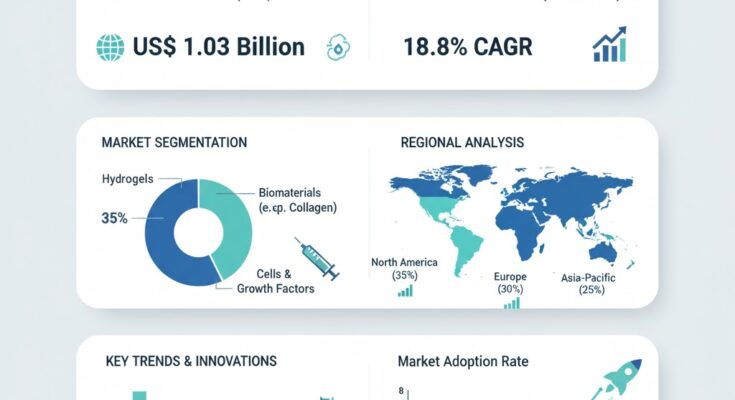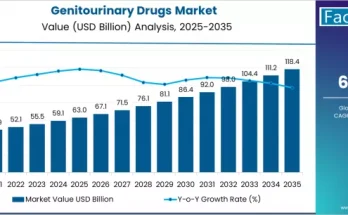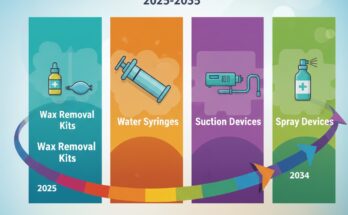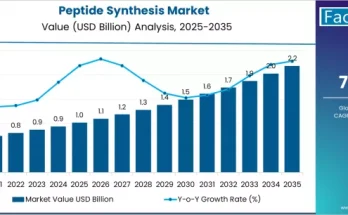The global bioink market is set for explosive growth as the biotechnology, pharmaceutical, and healthcare industries accelerate research in 3D bioprinting and tissue engineering. According to a new study published by Fact.MR, the market is estimated at US$ 185.6 million in 2024 and is projected to surge to US$ 1.03 billion by 2034, expanding at an impressive CAGR of 18.8% during the forecast period.
As the demand for engineered tissues, artificial organs, and personalized healthcare solutions rises globally, bioinks critical materials for 3D bioprinting—are emerging as transformative enablers of medical innovation. These advanced biomaterials, composed of living cells and biocompatible matrices, allow scientists to create complex biological structures with unprecedented precision and functionality.
Strategic Market Drivers
- Surge in 3D Bioprinting and Regenerative Medicine Applications
The expanding use of 3D bioprinting for producing tissues, scaffolds, and organ models is a major catalyst for bioink market growth. Healthcare researchers and pharmaceutical companies are leveraging bioprinted models for drug testing, wound healing, and regenerative therapies.
Bioinks provide the structural and biological compatibility necessary for successful cell proliferation, differentiation, and tissue formation, supporting breakthroughs in customized and on-demand bioprinting applications.
- Growing Investments in Personalized and Precision Medicine
The global shift toward personalized medicine—tailored to individual genetic and cellular profiles—is fueling bioink innovation. Bioprinted tissue models offer more accurate predictions of human biological responses compared to traditional animal testing, reducing R&D time and improving drug development outcomes.
Government-backed funding and private sector investments in tissue engineering and organ regeneration are also accelerating commercialization of bioinks for clinical-grade applications.
- Material Science Innovations Driving Product Performance
The bioink landscape is witnessing rapid advancements in hydrogel formulations, natural polymers, and synthetic blends. These materials enhance cell viability, mechanical strength, and biocompatibility.
Manufacturers are introducing next-generation bioinks with controlled degradation rates, tunable viscosity, and responsive properties—enabling superior performance in high-precision bioprinting platforms.
Regional Growth Highlights
North America: Bioprinting Research Powerhouse
North America dominates the bioink market, supported by robust biomedical research infrastructure and strong collaboration between academic institutions and biotech firms. The U.S. leads the charge, with universities and startups pioneering tissue engineering and organ-on-chip technologies.
Regulatory support for advanced biomanufacturing and strategic investments in healthcare innovation are further propelling market growth.
Europe: Advancing Clinical Adoption and Sustainability
Europe’s bioink market is driven by cutting-edge R&D, sustainable material innovation, and increasing use of bioprinted tissues in pharmaceutical testing. Countries such as Germany, Sweden, and the U.K. are key hubs for biofabrication, integrating digital manufacturing and regenerative technologies.
EU-backed programs promoting ethical bioprinting and the circular bioeconomy are boosting regional innovation pipelines.
Asia Pacific: Expanding Biomedical Manufacturing Base
Asia Pacific is emerging as a rapidly growing market, fueled by rising healthcare investments, academic research collaborations, and the development of biomanufacturing clusters.
China, Japan, and South Korea are spearheading advancements in stem cell research, while India’s expanding biotech ecosystem is supporting affordable bioink production for local and export markets.
Market Segmentation Insights
By Material Type
- Natural Polymer-based Bioinks: Derived from collagen, gelatin, and alginate, offering superior biocompatibility for tissue regeneration.
- Synthetic Polymer-based Bioinks: Provide mechanical stability and consistency for high-resolution printing.
- Hybrid Bioinks: Combine the strengths of natural and synthetic materials for advanced biofabrication.
By Application
- Tissue Engineering: Dominates market demand due to rising need for artificial tissues and scaffolds.
- Drug Discovery and Development: Bioinks are used for bioprinted organ models to test drug efficacy and toxicity.
- Regenerative Medicine: Emerging applications in wound healing, cartilage repair, and organ regeneration.
Challenges and Market Considerations
While growth prospects remain promising, the bioink market faces notable challenges:
- High Production Costs: Bioinks require specialized synthesis and quality control, impacting scalability.
- Standardization and Regulatory Hurdles: Lack of uniform bioprinting standards and complex approval pathways hinder commercialization.
- Storage and Stability Issues: Maintaining bioink integrity and cell viability during storage and transport poses technical barriers.
Competitive Landscape
The global bioink market is highly innovation-driven, with manufacturers focusing on developing high-performance, cell-compatible bioinks for diverse biomedical applications.
Prominent companies are emphasizing product differentiation, collaborations, and mergers & acquisitions to strengthen their technological edge and global reach.
Key Companies Profiled:
- Illumine, Inc.
- Merck KGaA
- CELLINK
- CollPlant Biotechnologies Ltd.
- Humabiologics
- Allevi, Inc.
- Black Drop Biodrucker GmbH
- Foldink
- UPM Biomedicals
- Axolotl Biosciences
- Manchester BIOGEL
- TheWell Bioscience Inc.
- 3DPL
Competitive Developments:
- November 2021: CollPlant launched Collink.3DTM, a recombinant human collagen-based bioink designed for 3D bioprinting of organs, scaffolds, and tissues.
- August 2021: BICO acquired Advanced BioMatris, a U.S.-based company specializing in collagen bioinks and modified proteins for 3D research applications.
Future Outlook: Shaping the Next Frontier in Bioprinting
The coming decade will redefine biomedical manufacturing through smart bioinks, AI-driven design systems, and sustainable production processes.
Manufacturers are expected to integrate automation, digital monitoring, and eco-friendly biomaterials to meet the next generation of healthcare demands.
With rapid adoption across regenerative medicine, pharmaceutical R&D, and tissue modeling, the bioink market is poised to become a cornerstone of the biomanufacturing revolution. Companies that invest in innovation, cross-sector collaboration, and regulatory alignment will lead the transformation toward a future where 3D-printed organs and tissues become a medical reality—bridging the gap between science and human life.



